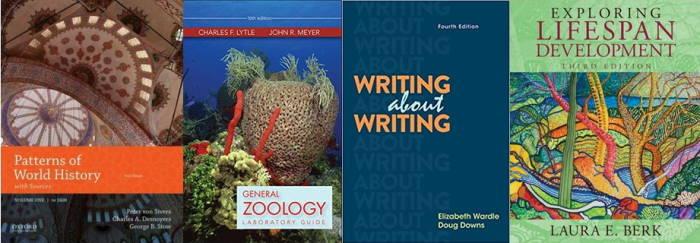
Helping Students with Textbook Costs

As many people have undoubtedly noticed, textbook prices can be ridiculous. While some textbooks are reasonably priced, others cost hundreds of dollars. These can add considerably to the cost of going to college. Many students have responded by not buying textbooks, buying older editions or otherwise trying to secure a cheaper copy. And for students on financial aid, they sometimes could not buy their textbooks until their financial aid came through, which could be weeks into the semester, leaving them struggling to stay current in their classes.
Many textbooks these days come with an online component – study guides, practice quizzes and other materials – that the book buyer gains access to via an “access card” that is typically good only for one semester and that includes license terms restricting it to one user. For libraries, this means we cannot share the access cards with students; for student buyers, that means the second owner of a textbook cannot use the access card.
The SU Bookstore has made some efforts to deal with textbook costs, but this article – since it’s in the SU Libraries newsletter – focuses on some actions the SU Libraries have taken. For many years, academic libraries, including at SU, resisted requests from students that we buy textbooks. Libraries traditionally have tried to buy books that had lasting value for the curriculum or research, and textbooks do not fit the bill. Publishers issue new editions every several years, meaning books go out of date quickly. But several years ago, after learning that some students were having to choose between buying textbooks and buying food, we decided to change our policy and begin buying textbooks to put on reserve.
We cannot, of course, afford to buy every book being used for every course – that probably would use more than our entire book budget! Instead, each year, we decide which textbooks to buy based on course enrollments; courses with high rates of grades of D, F or W (withdraw); and courses with particularly high textbook costs. We have been fortunate to have donors step forward to help us pay for these books.
With the pandemic, we were no longer able to loan physical copies of our textbooks on reserves. There was no good way to clean them quickly between uses. Instead, we began loaning digital versions. Like our physical loans, we only did these one at a time – that is, we wouldn’t lend a digital version to more than one user at a time. And, we are pleased at how popular the service has been! We made more than 1,700 loans for 46 different courses from 18 different departments. The total number of page views was over 106,000! Here were the four most popular titles:
- Patterns of World History, Volume One (to 1600), 3rd ed., for HIST 101, 401 loans
- General Zoology Laboratory Guide, 16th ed., for BIOL 213, 212 loans
- Writing about Writing, 4th ed., for ENGL 103, 210 loans
- Exploring Lifespan Development, 3rd ed., for PSYC 300, 181 loans
We will be resuming physical reserves this fall, but we intend to continue doing digital lending as well. Meanwhile, we also are working with faculty to encourage more use of free, open, educational resources – but that is a topic for another issue of the newsletter.